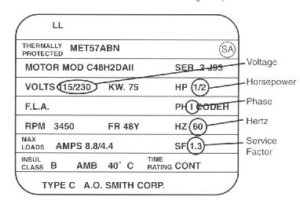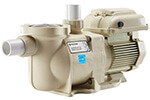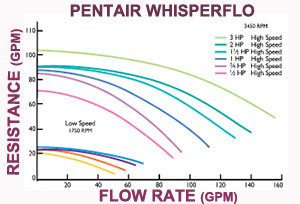FREE Standard Shipping On All Orders $100 or More!*
National Variable Speed Pool Pump Law
Energy efficiency is top of mind for many right now, and regulations are constantly changing to encourage further reduction in energy requirements for households. New legislation will soon be going into effect, and after July 19, 2021, variable speed pumps will soon be taking the place of many single speed pool and spa pumps that don't meet the minimum efficiency requirements outlined by the Department of Energy (DOE). All pumps manufactured after this date must meet minimum efficiency standards being put in place for U.S. homes and businesses.

Years in the making, this new law involved input from manufacturers, trade associations, utility companies and consumer groups. The result was a new set of standards that would be fair and attainable across the board. As a result of their many meetings, the Office of Energy Efficiency and Renewable Energy published a document in September of 2018 titled "Energy Conservation Standards for Dedicated-Purpose Pool Pump Motors."
Efficiency standards will vary slightly depending on the size and type of pool pump, but it's worth noting that only a small handful of single speed pumps will meet the criteria. The regulations don't just apply to pool filtration pumps, either – all pumps are subject to the new DOE regulations, regardless of application. But what does this mean for you and your pool? Let's dig into some of the most common questions about the new pump regulation changes happening in 2021.
DO I HAVE TO BUY A NEW FILTER PUMP?
You do not have to replace the single speed pump currently installed in your pool if it's still in good working condition. After the July 21, 2021, deadline, it will get progressively harder to find large single speed pumps that you would typically find on an inground swimming pool. It's not that you can't purchase or install them (if you can even find inventory through your favorite pool store), it's just that the manufacturers can no longer produce pumps that don't meet minimum efficiency standards. That said, most single speed pumps will eventually be replaced by a variable speed counterpart as the supply chain moves toward energy efficiency. When it's time to upgrade your pump, we highly recommend upgrading to a variable speed pool pump to take advantage of the incredible energy savings, which will be reflected in your monthly utility bill. all new or replacement filter pumps over 1.0 THP must be variable speed.
THP? WHAT IS TOTAL HORSEPOWER?
Horsepower (HP) x Service Factor (SF) = Total Horsepower (THP)
Total Horsepower is the product of multiplying Horsepower (HP) and Service Factor (SF). Under the new regulations, pumps with greater than 1.0 THP must be a variable speed pump. However, even single speed pumps less than 1.0 THP are still subject to minimum efficiency requirements, and may not be eligible for production.

Let's look at a couple of examples. If you have a 0.75 HP motor, with a 1.65 SF, the Total Horsepower is equal to 1.24. This is greater than 1.0 THP, so under the new regulations, this pump would need to be a variable speed model.
In another example, with a 0.75 HP motor with a 1.10 SF, the THP is only 0.825 HP. In this case, a variable speed pump is not required, and the pump could be single speed. In most cases, you will find both HP and SF printed on the motor label.
ARE THERE EXEMPTIONS OR EXCEPTIONS?
Yes, there are a few exceptions to the rule. At this time, the DOE is specifically concerned with inground pool pumps. The federal mandate does not currently spell out minimum efficiency requirements for any of the following:
- Pool pumps greater than 5.0 THP (such as commercial pumps).
- Waterfall pumps, which are specifically manufactured and labeled as a waterfall pump.
- Integral sand and cartridge pump and filter units used on portable pools.
- Rigid spa filter pumps and circulation pumps.
Contrary to popular belief, pool cleaner booster pumps used for certain kinds of pressure cleaners are still subject to minimum efficiency requirements spelled out in the new DOE regulations. However, the vast majority of booster pumps used for this purpose already meet the efficiency guidelines. Also, most non-self-priming pumps, which are often used for above ground pools, follow the minimum efficiency standards for single speed pumps.
ARE THERE ANY LOOPHOLES?
Very few. As we mentioned earlier, at least in the short term you may be able to still find some remaining stock of single speed pumps greater than 1.0 THP still available. As for In The Swim, and most other online retailers, we do not intend to sell such pumps after July 21, 2021.
You also may find, at least in the short term, replacement single speed motors greater than 1.0 THP. The language of the standards has not specifically addressed replacement motors, however that will likely be amended in the near future.
WHAT'S SO GREAT ABOUT VARIABLE SPEED PUMPS?

The biggest advantage is that a VS pump can save you as much as 40-80% on your monthly energy bill by consuming less electricity. The range is dependent upon how you use it and the level of resistance in the plumbing and the filter system. VS pumps save the most money when they are run on low speeds most of the time, with higher speeds used only as needed, such as to increase filtration, run the pool cleaner, or to heat the pool.
System resistance is an important, but often overlooked piece of the puzzle. Using 2-inch plumbing without a lot of twists and turns (excessive 90° elbows) has less resistance to overcome. Large cartridge filters are best, because they have no backwash valve. Slide valves have much less resistance than multiport valves. You can learn more about getting the most from your pool pump here: Optimizing Variable Speed Pump Savings
In addition to energy savings, VS pumps are often much quieter and cooler to the touch. Their motors tend to last longer than standard single speed motors, meaning they'll cost less to maintain over time.
HOW ARE VARIABLE SPEED PUMPS INSTALLED?
Just like any other pump, there's really no difference. The larger VS pumps are generally wired with 230V, while certain other VS pumps can accept either 115V or 230V power. The way you plumb them is exactly the same. There's one pipe in, one pipe out, and it's attached with a thread sealant, such as Teflon tape. Wiring is also the same. You can learn more here: Installing a Variable Speed Pool Pump
WHAT IS THE BEST VARIABLE SPEED PUMP FOR MY POOL?

The first thing to note is that there are high flow VS pumps, like Pentair Intelliflo and Hayward Ecostar, and medium flow VS pumps like Hayward Superpump VS and Pentair Superflo VS. We also have new variable speed pool pump models by Waterway and Jacuzzi.
The second thing you may have just noticed, is that many manufacturers have taken the chassis from their most popular models, and added the variable speed motor, recognizable by the "drive," or the square box sitting atop the motor.
If your current pump is available in a VS version, that would be the simplest installation. This is because the plumbing will line up, the flow characteristics will match your current pump, and it will also match the design flow rate of your pool filter.

If your current pump has not been converted into a VS model, check the flow curves to select a VS pump that has similar flow rates based on the flow curve.
VS pumps are available in a range of 1.4 HP to 2.7 HP. Buying a VS pump that is too large for your filter and plumbing will not save as much energy as hoped, and can cause cavitation issues. See more here: Best VS Pool Pumps
CAN ABOVE GROUND POOLS USE VARIABLE SPEED PUMPS?
Sure, savings for everyone! Like an inground pool, just be sure that the flow rates shown in the pump flow curve match fairly closely to the filter design flow rate, and do not exceed with higher flow rates.
For above ground pools, the smaller VS pumps like the Waterway 140 and the Jacuzzi 160 or the Raypak VSP pumps are among the best choices for an above ground pool variable speed pump. They're also a fine choice for smaller inground pools up to 25,000 gallons.
Be an early-adopter, and take a look at our huge variable speed pump selection to start shopping today! A dozen different models are available.